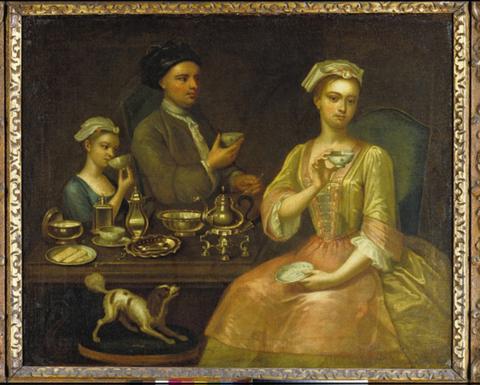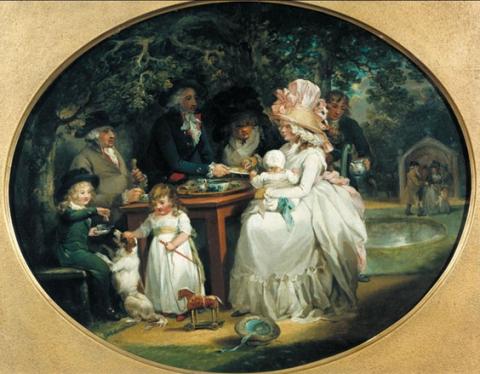After careful thought, we will be discontinuing the Music Monthly newsletter.
Anyone for a Cuppa?
Anyone for a Cuppa?
17 May 2020
Anyone for a cuppa? by Jeni Fraser
A Family of Three at Tea is one of the earliest known depictions of English people drinking tea. The artist, Richard Collins, created this painting in 1727 and it is now in the collection of the V&A. When painting 'conversation pieces' (relaxed portraits of family groups or gatherings of friends), artists were expected not only to show their sitters in fine clothes, but would also be obliged to include valuable possessions, indicating their wealth and social status; so Collins shows this fashionably-dressed group enjoying the novel luxury of a hot beverage from the Far East using porcelain tea bowls imported from China,
Tea had been virtually unknown in Europe until the 1650s, when it was popularised by a charismatic Jesuit missionary named Father Alexander of Rhodes. Tea only really caught on in Britain after the restoration of the Stuart monarchy. Its sudden, rapid rise in popularity can be at least partly attributed to the influences of Charles II’s Portuguese bride, Catherine of Braganza. The story goes that immediately on arrival at Portsmouth from Portugal, on 13 May 1662, Catherine demanded a cup of tea. To their great embarrassment, the welcoming party had none. She was offered a glass of warm ale, which she turned down in disgust.
The aristocracy and gentry quickly followed the example set by royalty, and the newly established East India Company began importing tea to England in ever-increasing quantities. The English custom of taking milk with tea – note the prominent silver milk jug on the table in Collins’ portrait – may reflect political changes in China at the moment when English imports began to accelerate. The Manchu invasion of 1644 ended the Ming dynasty, which considered the addition of dairy produce to tea a repulsive practice. The conquering Tartars had long added milk to their tea, and it was presumably from them that the English acquired the habit.
Afternoon tea is said to have originated with one person; Anna, 7th Duchess of Bedford. In the early 1800's she launched the idea of having tea in the late afternoon to bridge the gap between luncheon and dinner, which in fashionable circles might not be served until 8 o'clock at night. This fashionable custom soon evolved into high tea among the working classes, where this late afternoon repast became the main meal of the day.
The historian Peter Brown goes so far as to suggest that the ‘groundswell in demand for objects needed to consume (hot) chocolate, coffee and tea helped prompt the rise of the industrial revolution in Britain … transforming the country from a largely agrarian culture to one founded on a product based economy. Which suggests the Collins’ Family of Three at Tea is a deceptively peaceful record of English society in the cusp of a great economic shift.
Illustrations: Richard Collins, A Family of Three at Tea, 1727, V&A collection
George Morland, The Tea Garden, engraved 1790, Tate
There is a storm brewing in those elegant porcelain teacups.
jenifraser.co.uk 'Anyone for a cuppa?' Copyright Jeni Fraser 2020
About the Author
Jeni Fraser
JOIN OUR MAILING LIST
Become an instant expert!
Find out more about the arts by becoming a Supporter of The Arts Society.
For just £20 a year you will receive invitations to exclusive member events and courses, special offers and concessions, our regular newsletter and our beautiful arts magazine, full of news, views, events and artist profiles.
FIND YOUR NEAREST SOCIETY
MORE FEATURES
More than twenty members of our Arts Society flew out in October 2025 for a short but fascinating trip discovering th
Year in Review: A Remarkable Year for The Arts Society Mallorca






